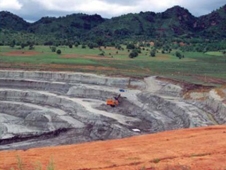Burma's biggest open-cast coal mine 'poisoning rivers'
Published by MAC on 2011-01-31Source: Democratic Voice of Burma, Mizzima
Burma isn't just one of the most politically-closed states on the planet. It's also rare to find accounts emerging about the socio-environmental impacts of its many mines.
But, in January, a fairly lengthy report by the Pa'O Youth Organisation did emerge, describing existence in the shadow of the country's biggest coal mine.
A link to the report itself is at http://www.scribd.com/doc/47176385/Poison-Clouds-English
Note: The same organisation also published a report, Robbing the Future, in June 2009 on Burma's biggest iron mine & the Pangpet No. 5 Steel Mill in Shan State.
Major coal mine 'poisoning rivers'
By Francis Wade
Democratic Voice of Burma
21 January 2011
Burma's biggest open-cast coal mine is polluting waterways and causing displacement of communities on an alarming scale, a new report warns.
 |
| Digger works on the Tigyit mine in Shan state - Source: PYO |
The Tigyit mine close to Shan state's Inle Lake produces some 2000 tonnes of lignite, often referred to as brown coal, each day. The Poison Clouds report by the Pa'O Youth Organisation (PYO) claims that it is damaging the health of locals there.
Problems with transporting lignite mean that it is often burned in power plants close to its source which produce much higher carbon dioxide emissions than black coal.
Images released by PYO show hazardous coal dumps forming veritable mountain ranges close to inhabited areas. The run-off from these can work its way into rivers that feed into Inle Lake, Burma's second-largest, with knock-on effects for farmers and fisherman palpable.
"Dump piles from the mine are now towering above the homes of 3,000 people, blocking streams and contaminating fields," a statement released with the report reads. "Dust and emissions, including from poisonous waste scattered on local roadways, is seriously degrading air quality. To date 50 percent of the local population is suffering from skin rashes."
It adds that nearly 12,000 people living within a five-mile radius of Tigyit may be driven from their homes by pollution and expansion of the mine, which currently covers 500 acres.
Two nearby villages have already been relocated. The 321 inhabitants were paid compensation that amounted in total to $US6,280 - less than $US20 each.
Instead of the electricity being produced by the nearby plant going to local populations, the report claims it is channeled to another mining project run by Russian and Italian companies. "This follows the trend in Burma's energy sector of exploiting natural resources not for the development of the country's people but for sale to the highest bidders," it says.
Burma currently has seven operational coal mines, although an additional 10 have been discovered. Only one coal plant processes the output at present, but six more are either planned or under construction.
2,000 people report skin diseases from Tigyit coal mine
By Kyaw Kha
Mizzima
21 January 2011
Chiang Mai - The largest coal mine in Burma, Tigyit, has created air and water pollution which has caused about 2,000 nearby residents to report skin diseases, according to a report released by the Pa-O Youth Organisation.
The report, ‘Poisoned Cloud,' released on Thursday in Chiang Mai, Thailand, says the massive open-pit coal mine project in Pinlaung Township in southern Shan State has led to skin diseases and itching in about half of the 4,080 residents in nearby Tigyit and Se Gaung villages.
‘The coal mine releases gas and foul smells, and moreover the pile of waste disposed by the mine is higher than the village. Because of the air and water pollution, people have symptoms of skin diseases', PYO Secretary Khun Chan Khe said at press briefing.
The Tigyit coal mine is among 16 coal mines in Burma and produces about 2,000 tons daily.
The China National Heavy Machinery Corporation initiated the Tigyit project in 2002 about 16 miles from Inle Lake, in partnership with the Burmese companies Eden Group and Shan Yoma Nagar Company.
Coal production from the mine produces at least 100 tons of ash and waste which is disposed in a nearby coal-fired thermal power plant, whose water flows into Belu creek, said the report.
There are about 25 villages within a 5-mile radius of the project which are home to about 11,592 people, all of whom are under a health risk.
When the project was started, 24 houses in Taung Po La and Likah villages were forcibly relocated by companies and local authorities. The project was then expanded and farmlands of local people were also seized by the authorities, the report said.
Win Myint of the Rhakine Nationalities Development Party told Mizzima that the coal mine was the direct cause of the air pollution which has made nearby residents break out in skin diseases.
The waste water released by the coal mine project also flows into upper Belu creek and then flows into the second largest lake in Burma, Inle Lake, which is an Asean national heritage site, the report said.
‘Conservation and the all-round development of Inle Lake is our first priority, and we must guard against projects which damage the lake', Win Myint told Mizzima.
Most of the local population in the affected area is ethnic Pa-O with smaller concentrations of Shan, Burmese and Taung Yo. Local people grow millet, paddy, tea, cabbage and chili for their livelihood.
It is estimated that Burma has a total coal reserve of more than 270 million tons.
The Pa-O Youth Organization and Kyoju Action Network have monitored the project since February 2010.